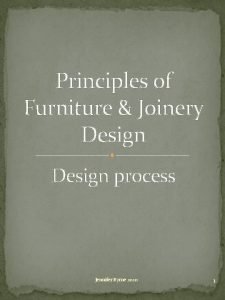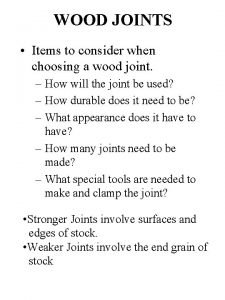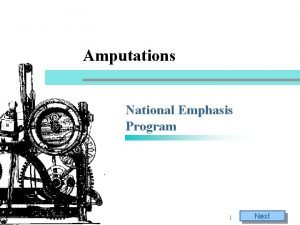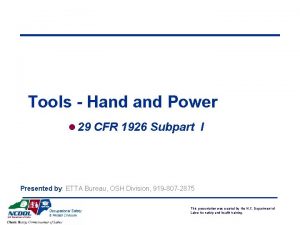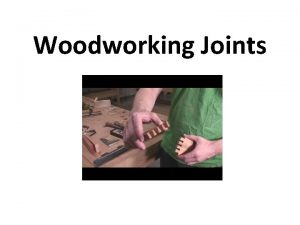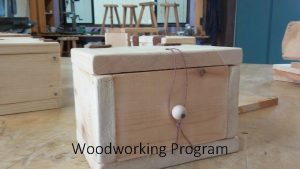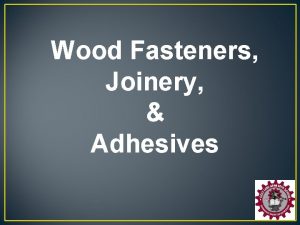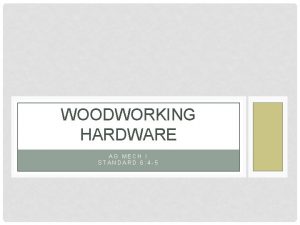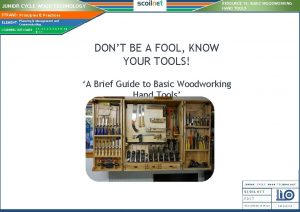WOODWORKING JOINERY Joinery What is joinery In our
















- Slides: 16

WOODWORKING: JOINERY

Joinery �What is joinery? • In our case – we will be looking at the fastening or combining of two or more boards together when building our projects. �It is important to have good, strong joints when building furniture. �It is sometimes good to use both advanced joinery methods and fasteners when assembling the project.

Butt Joints � Used to join 2 boards • Edge to edge • End to side • End to edge � Very simple form of joinery

Dado Joints Slot or groove is cut across the width of a board (on the inside) when joining 2 boards together � Boards are joined at right angles to one another � Remove a portion from one board to accept the other board (usually half the thickness of your material) �

Rabbet Joints � Similar to a dado joint � Remove material from the end or edge of a board � Makes the boards connect at a right angle to one another

Spline Joints � � � The spline is the strip of wood used in the center of this joint. The spline is inserted into matching grooves/troughs on two boards. Splines are often used to reinforce miter or butt joints. Spline can also help align the pieces for the glue-up procedure. You can also use a spline joint as a decorative accent in your project.

Mitre Joints � The division, into 2 equal parts, of an overall angle created by 2 intersecting parts • Most frames that use miter joints meet at 90˚ so the two pieces are cut at 45˚ � Precise cuts are very important – you will see gaps and have a less secure joint if your cuts are not accurate

Lap Joints (ie. end-lap, half-lap) � Remove the full width of the intersecting wood pieces. � The two parts meet and together make up the entire thickness. � Should be used with fasteners as well in order to increase the strength of the joint.

Tongue-And-Groove Joints �A short tongue is cut along one edge. � A matching groove is cut along the edge of the other board. � Good to use when making a wider panel from narrow boards.

Box Joints � Cut straight slots and grooves out of the end of two boards in order to form an interlocking system at the corners. � Sometimes referred to as a finger joint. � Used for decorative reasons as well as to strengthen the assembly.

Mortise-and-Tenon Joints � Join two pieces of wood at an angle (usually 90˚) � A tenon (a portion that sticks out) is cut on the end of one board. � A matching recess, slot or hole is cut into the other piece (mortise). � The two fit together to make a strong joint that is frequently used in furniture making.

Dovetail Joints A system of pins and tails that interlock together. � Tails are the triangular shape cut through the thickness of a board. � Pins are more slender portions cut along the grain of the other board. � One of the strongest joints. � Also very attractive for of joinery. �

Dowel Joints � Cylindrical piece of wood used to join two pieces of wood together. � Holes are drilled into both pieces of wood at precise locations. � The dowel (cylindrical piece) fits into the hole on either side. � Makes a butt joint more secure.

Biscuit Joint � Thin football shaped disk is used to join two boards together. � A slot is cut into each board. � The biscuit fits halfway into each side of the slot. � The biscuit expands with the glue to fill the gap.

Fasteners What are the different types of fasteners?

Your task…. � Define the term fastener as it would be used in the woodshop. � Choose 3 -4 specific types of fasteners (ie. Glue, nails, screws, tape, etc. ) and describe its benefits. • For example – Robertson screw, Gorilla Glue, and roofing nails • Why would we use waterproof glue over regular wood glue. • Why do some nails have “twists” along the shank? � Do not write a novel – but make sure you have enough information about each. � If you would prefer to do a Power. Point over a Word document – then do so!
 Joinery design
Joinery design Joinery and cabinet making
Joinery and cabinet making Types of joint wood
Types of joint wood Whats emphasis
Whats emphasis Classify the different types of tools and materials hinge
Classify the different types of tools and materials hinge Fixed power driven woodworking tools
Fixed power driven woodworking tools Our census our future
Our census our future God our father christ our brother
God our father christ our brother Christ, be our light shine in our hearts
Christ, be our light shine in our hearts Our life is what our thoughts make it
Our life is what our thoughts make it Our future is in our hands quotes
Our future is in our hands quotes Marcus aurelius our life is what our thoughts make it
Marcus aurelius our life is what our thoughts make it We quail, money makes us quail.why?
We quail, money makes us quail.why? Thinking language and intelligence
Thinking language and intelligence Our awareness of ourselves and our environment
Our awareness of ourselves and our environment We bow our hearts
We bow our hearts Awareness of ourselves and our environment is
Awareness of ourselves and our environment is
